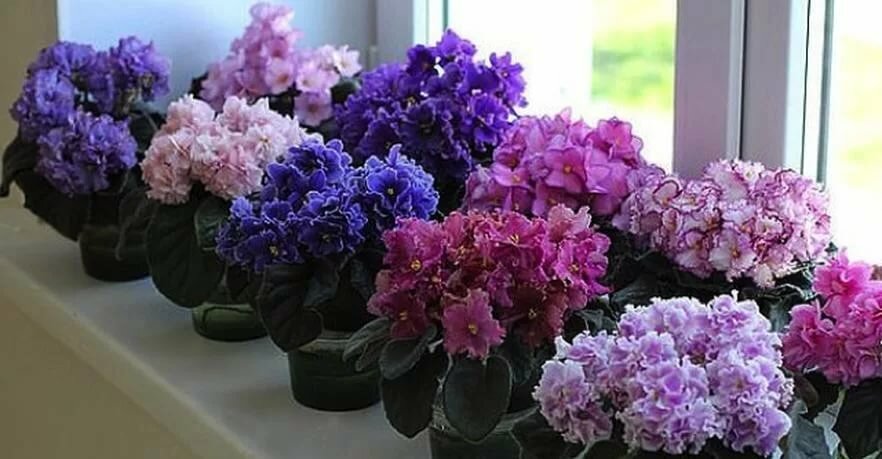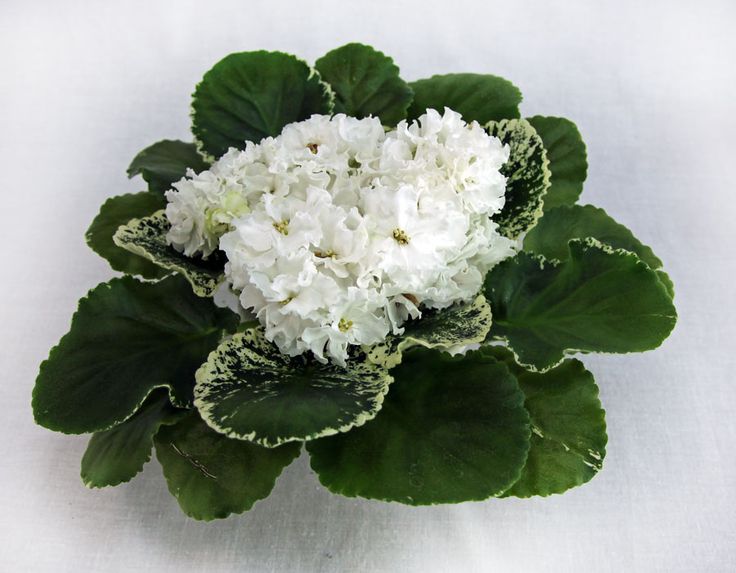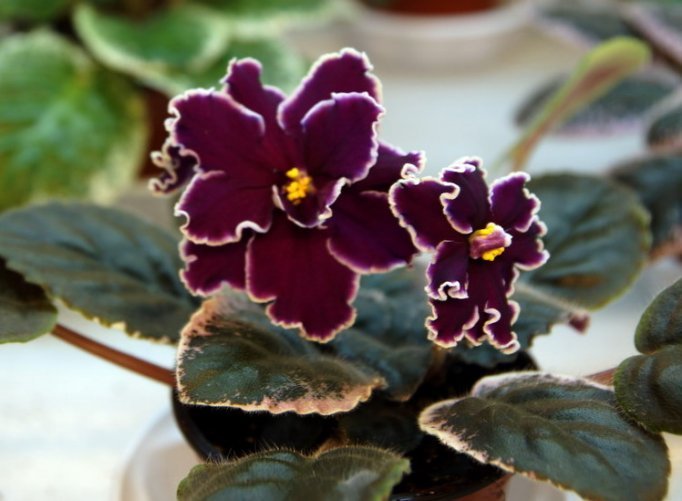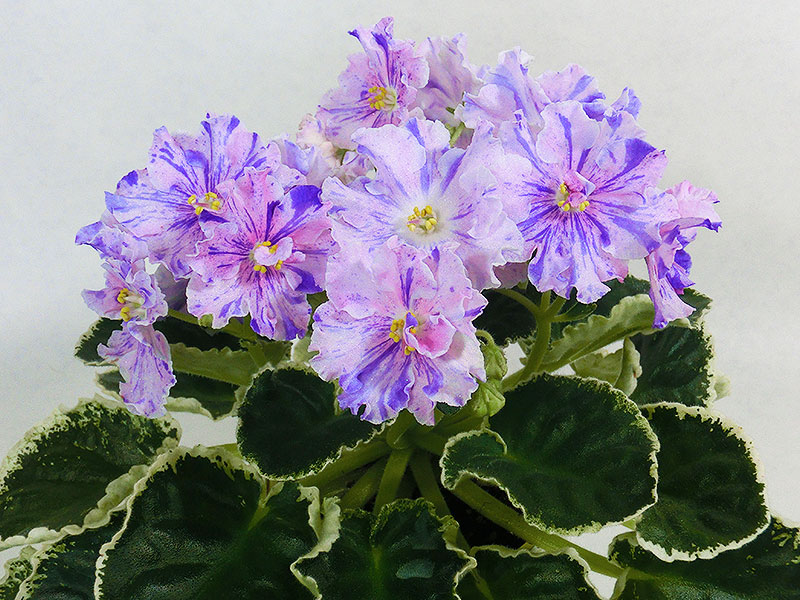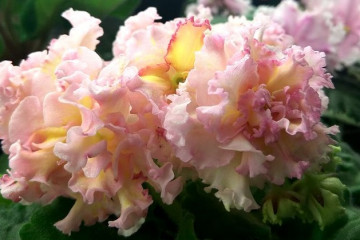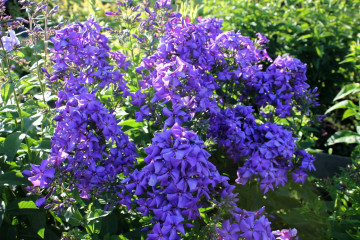What does violet Le look like - description of varieties
Content:
Indoor Saintpaulias surprise with a wide palette of colors of their flowers. Some capriciousness of violets does not stop amateur flower growers and professional breeders. The number of admirers of this beautiful plant is constantly increasing.
The history of the appearance of the first varieties
Breeder from Vinnitsa Elena Lebetskaya began to create new varieties in 2000. Today Lebiecka violets (LE) have more than 250 varieties. They amaze the imagination with a variety of colors and shapes of flowers. The collection includes varieties with petals from the simplest to terry, with wavy, fringed and corrugated edges. Among them there are monochrome ones and with the presence of strokes, strokes and spots, surrounded by a border and colored with splashes of contrasting shades. The leaves draw attention to themselves with the velvety texture of pure green tones of varying saturation. Rosettes of variegated species captivate with drawings and colored stains on the sheets.
Description of colors
Usambara violets, native to the mountainous regions of eastern Tanzania, became the progenitor of all indoor violets. Once in Europe, they received the name Saintpaulia, after the discoverer of the flower, Baron Walter Saint Paul. Many people incorrectly classify Saintpaulia as forest violets. Saintpaulia belongs to the Gesneriaceae family. This is a herbaceous low plant with leaves collected in rosettes. Shaggy, rounded leaves are located on short petioles.
Flowers forming brushes, different in shape:
- Simple - with regular petals.
- Semi-double - have several underdeveloped petals in the middle of the flower, which makes the flower more voluminous.
- Terry - the petals are arranged in several rows.
Usually there are up to 7 flowers in a brush, currently hybrids with up to 100 flowers have been created. In culture, violet saintpaulia (uzambar) is widespread - this is one species, all existing forms are its hybrids.
Among indoor violets, 5 types are distinguished according to the shape of the flower:
- "Bowl" - the petals are separate, the bud does not fully open and retains its shape during flowering.
- "Wasp" - resembles a cyclamen, 2 upper petals are short, bent back, 3 lower ones - directed in different directions and are almost dissected, which is unusual for the Gesnerievs.
- "Bell" - dark blue with a violet shade flowers in the form of bells with wavy edges of the petals.
- "Pansies" - 4 large petals raised up and 1 - lowered down.
- "Star" - large light purple buds in the shape of a star with a light border along the contour.
Among the varieties from the selection of Elena Lebetskaya, one can distinguish both simple-shaped monophonic flowers, and those that captivate with the play of colors, and surrounded by a fringed edge or a contrasting shade of border. Each in its own way is beautiful and worthy of attention. Varieties with a multicolored color have two or more colors, fantasy varieties differ in that there are stripes on the main background, strokes of a lighter or darker tone than the main one.
The structure of the roots is the same for all varieties. Stems and leaf stalks may vary in height. The sockets are distinguished by the size:
- Miniature - with a diameter of up to 15 cm.
- Standard - from 20 to 40 cm.
- Large - over 40 cm.
Flower size
According to the size of the flower, Saintpaulia is divided into groups:
- Small-flowered are up to 2 cm in size.
- Mid-flowered - from 2 to 4 cm.
- Large-flowered have flowers ranging in size from 4 to 6 cm.
- Particularly large-flowered plants exceed 6 cm in diameter.
Number of flowers
The most common varieties contain up to 7 flowers. The Caramelka variety does not shine in number, but attracts with the refinement of its pink color. In Kristina, a small number of them are covered by the splendor of double flowers. Recently bred hybrids surprise with a large number of flowers, their number reaches a hundred. The White Camellia variety is distinguished by a lush blooming cap with a lot of flowers.
Color and pattern of the flower
In addition to monochrome, there is a huge variety of colors:
- Bordered - have a border along the edge of the petals, the color of which differs from the main one.
- Fantasy - have petals covered with strokes, splashes, dots of contrasting shades.
- Spotted - with a contrasting spot on the petal.
- Chimeras - contrasting rays go from the middle to the edge of the petal.
Admiration is caused by the White Camellia variety, the snow-white flowers of which are surrounded by a motley white-green rosette of leaves. The dignity of the variety - the flowers do not lose their color and shape throughout the flowering period. Violet Lotus conquers with double pink flowers, in shape they are like roses.
There are a huge number of varieties with one-color petals, in which their beauty is emphasized by the presence of a border of a contrasting color. One-color flowers of varieties LE Grazia white bell-shaped, LE Magnetto violet lilac with fringe look spectacular. LE Igor is a violet of the "pansies" type with 4 large bright blue petals, surrounded by a white wavy border, echoes the Summer Twilight variety of Morev's selection. LE Noir violet belongs to variegated forms. Its simple and semi-double large flower-stars are striking with a violet-fuchsia color and a wavy white border.
The unusualness of the multicolored petals of the Lebetskaya varieties is surprising. Violet LE Zlata (Zlata) strikes with white-yellow or gold in the form of a wavy star flowers with a thin variable blue border along the edge of the petal. The even rosette has slightly wavy green and white leaves. LE Elegance variety is distinguished by double white "pansies" with wavy petals, on the lower ones - bright caramel-pink specks. The variegated leaves of the Lena variety add charm to the semi-double and double petals of blue-green hues. The apotheosis of the colors of the Winter Surprise variety will not leave anyone indifferent: slightly wavy petals of light pink color are colored with strokes and stripes of soft purple tones.
Flowering period
With good care, violets endow with flowering almost all year round: up to 8-9 months. The flowering of Saintpaulias is not associated with the season, mainly depends on the growing conditions created for it. The most abundant flowering is observed in spring and summer. It is difficult to predict when exactly the plant will bloom. Violets grown from a leaf can bloom in 8 months, some need a whole year, sometimes they will have to wait a year and a half. There are varieties (breeding Sorano)blooming all year round:
- Emerald Pink with a variety of light coral pink flowers with a light green border.
- Anastasia, lightweight flowers with sky blue watercolor petals, marked with dark streaks, with corrugated edges.
Reproduction methods
For the reproduction of violets, vegetative methods are used:
- Seeds;
- Cuttings.
The seed method is quite lengthy and laborious; it is usually used for breeding by professional florists. At home, cuttings are used to obtain new copies. With a sharp knife, a leaf capable of forming adventitious roots is cut off, stepping back from the leaf plate by 2.5-3.5 cm.The cuttings are placed in a container with water and transferred to a warm, bright place. Cover with a plastic cup or plastic bag to create a greenhouse environment. Usually, after 2-3 weeks, the first roots appear, and the cuttings are transplanted into the ground. When the growth reaches 4-5 cm in height, the violet has taken root and began to grow, the parent leaf is cut off. For reproduction of variegated forms, cuttings are taken from the 2nd row, young and strong, they root more easily. At the same time, the most green leaves of the rosette are chosen.
There are varieties that cannot be propagated by cuttings from leaves, because they do not retain their parental characteristics. In this case, cuttings of peduncles are used, choosing the strongest and healthiest. Then they proceed as with ordinary cuttings, waiting for the roots to appear. In some varieties, lateral shoots are formed - stepchildren, they are removed and rooted like ordinary cuttings.
Care features
Caring for different species and varieties has general rules. Any irregularities in the care of senpolia lead to a deterioration in appearance and even a lack of flowering. A positive result in flower cultivation can be expected if certain rules are followed. The plant reacts to:
- Soil condition;
- Indoor temperature;
- Lighting;
- Irrigation mode and quality;
- Top dressing.
To avoid soil caking, it must be loosened between waterings. A comfortable temperature for a flower is 19-24 ° C. The violet is a light-loving plant, but, like most house pets, it does not tolerate direct sunlight. It is better to place it at a distance of 0.5 m from the window. Watering is carried out no more than 2 times a week, taking into account the humidity of the air. In this case, it is necessary to ensure that water does not fall on the growth point and leaves. A watering can with a long spout without a divider will become convenient. You can pour water into the pan, after 20 minutes, the remaining water is drained. During the period of active growth, every half a month, the flower is fed with a weak solution of complex mineral fertilizers for Saintpaulias.
In the collection of E. Lebetskaya, a large place is occupied by variegated forms, which look spectacular even without flowers, due to the presence of spots, specks of other shades on green leaves. These are places on leaf plates where there is no chlorophyll, instead of it there are other coloring pigments: carotene, xanthophyll and others. There are some subtleties when growing them. To preserve the variegation signs, efforts are made to reduce the amount of chlorophyll and release other pigments to change the color of the leaf.
When applying fertilizers, nitrogen-containing ones are excluded for the same reason - they contribute to the production of chlorophyll. Variegated violets react well to artificial lighting, so they can be placed on the lower shelves of the shelves, where it is cooler.
The rest of the care measures do not differ from the care of other forms of the plant.
Once having seen the charming Saintpaulias, everyone becomes their admirer forever and is eager to grow a new, unusual shape and color, a variety of an attractive flower.
